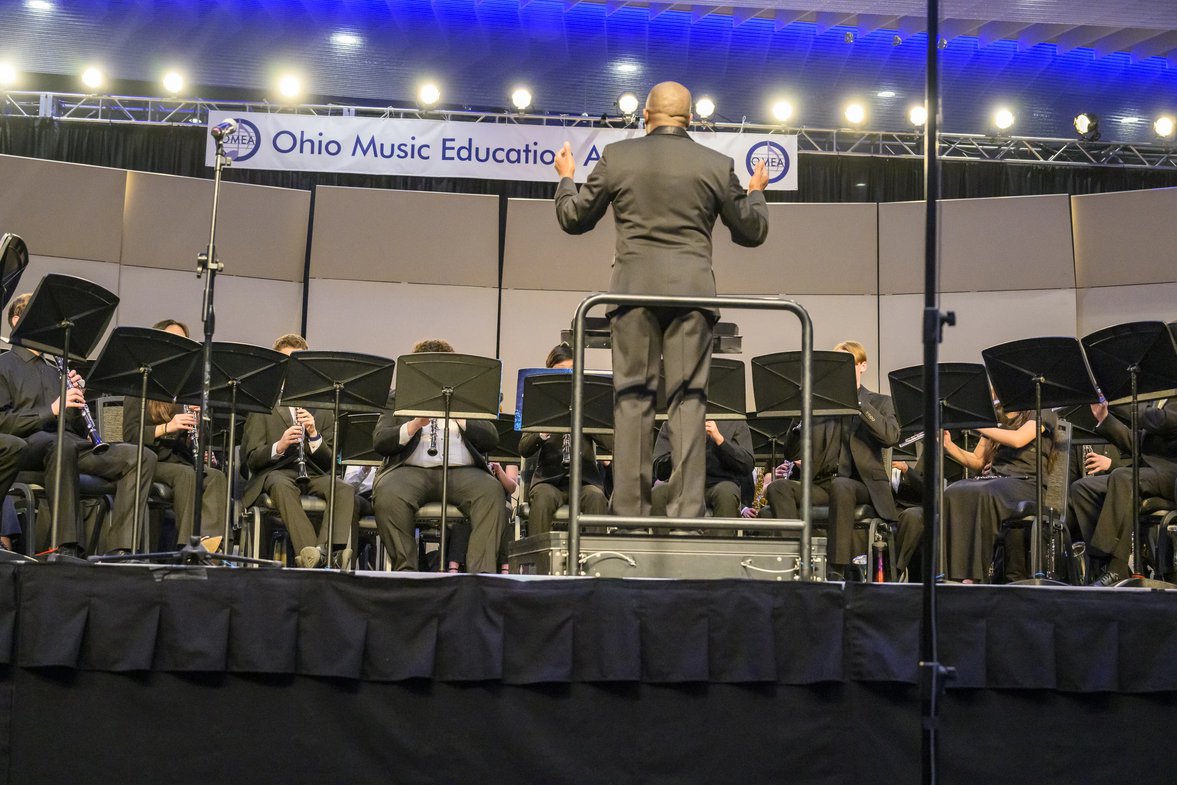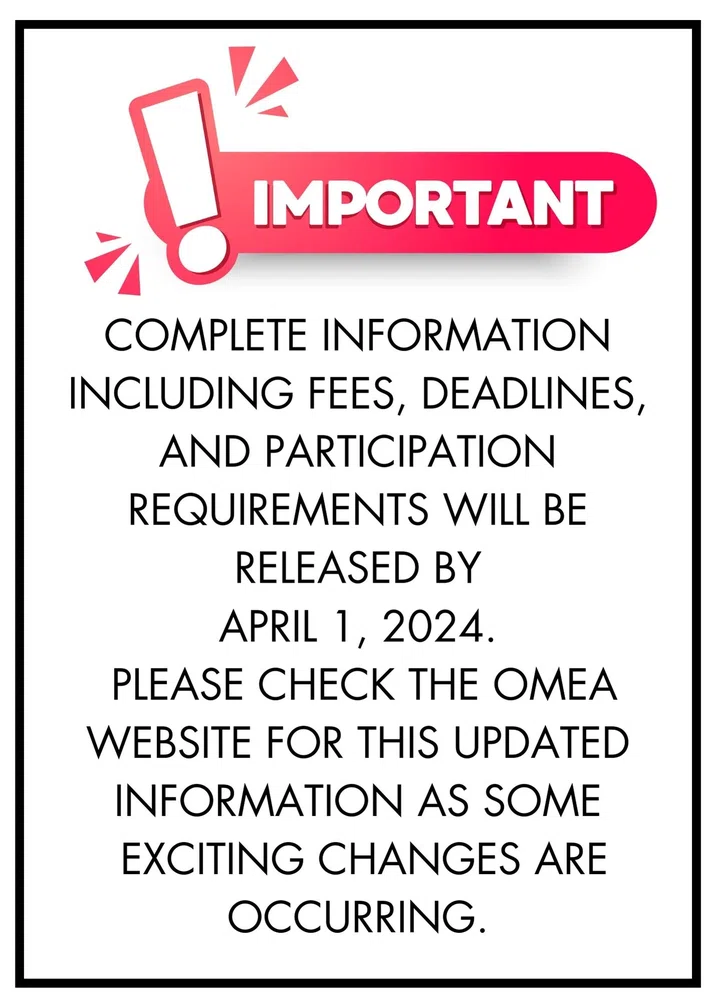©2023 Ohio Music Education Association



ALL STATE
All State Audition Announcement and Requirements
All State Audition Announcement and Requirements

2025 All-State Audition General Information
2025 All-State Audition General Information
All applicants must be currently enrolled as members of their school’s performing ensemble and must continue their participation during the 2024-2025 academic year (ex. All-State Band applicants must be members of their school’s band, All-State Choir applicants of their school’s choir, All-State Jazz applicants of their school’s jazz ensemble, All-State Orchestra applicants of their school’s orchestra or for wind/percussion of their school’s band ensemble.) Home school students may apply if sponsored by their private teacher (must be an OMEA member). A parent/guardian of the home-schooled student will serve as the school administrator. Students must be enrolled in grades 9-12 for the 2024-2025 academic year. Failure to observe these rules will void the student’s All-State eligibility.
OMEA is using the Accptd Online Digital Audition Platform for all 2025 All-State Ensemble auditions. Please be aware that the online application should not affect how recordings are made only how applications/recordings are submitted. Students will need the following items to apply:
- Student and parent e-mail addresses.
- Digital recordings of required etudes/solos/scales/warm-up (as listed below)
- The school ensemble director’s contact information
- The school ensemble director’s 9-digit NAfME identification number
- A credit card for the $20 application fee (paid to Acceptd).
April 1 - Accepted opens for All-State Applications
May 31 - Deadline for all applications to be submitted. Please carefully note the specific etude and performance requirements. They are all different for 2025.

2025 All-State Choir Recording Audition Information
2025 All-State Choir Recording Audition Information
Each student (after first announcing name and voice part) should record a vocalization (any vocal warm-up exercise) of the student’s choice that best demonstrates the extent of his/her range from bottom to top. Next, record a solo from the OMEA Class “A” or “B” list.
2025 All-State Band & Orchestra Winds & Percussion Recording Audition Information
2025 All-State Band & Orchestra Winds & Percussion Recording Audition Information
Each student (after first announcing name and instrument) will next record all required Etudes as listed on the next page and then record a Solo from the OMEA Class “A” or “B” list.
Percussionists are required to record all three etudes (mallet, snare, and timpani) and then record a solo (OMEA Class “A” or “B”) on a keyboard instrument (xylophone, vibraphone, or marimba). Two or four mallet solos are acceptable, and the solo may be accompanied or unaccompanied.
Flute
• Selected Studies for Flute by Voxman, published by Rubank - p. 7 and pp. 30-31 (Allegretto)
Oboe
• Selected Studies for Oboe by Voxman, published by Rubank - p. 13 and p. 53
Bb Clarinet
• Selected Studies for Clarinet by Voxman, published by Rubank - p. 17 and p. 34
Bass Clarinet
• Advanced Studies from the Works of J. Weissenborn, arr. Rhoads, published by Southern - #4 (p. 2) and #13 (p. 9)
Bassoon
• Method for Bassoon by J. Weissenborn: 50 Studies section in back of book (Catalogue #CU96) - #6 (p. 117) and #39 (pp. 144-145)
Saxophone
• Selected Studies for Saxophone by Voxman, published by Rubank - p. 12 and p. 44
Trumpet
• Selected Studies for Trumpet by Voxman, published by Rubank - p. 13 and p. 42
French Horn
• Preparatory Melodies to Solo Work by Pottag, published by Belwin - #32 (p. 12), #62 (p. 25) and #80 (p. 32) – Take D.S. al Fine for all three etudes
Trombone and Euphonium
• Selected Studies for Trombone by Voxman, published by Rubank - p. 19 (Largo cantabile) and p. 45 (Allegro moderato)
Bass Trombone
• 50 Etudes for Bass Trombone and Tenor Trombone with F Attachment by Grigoriev, ed./arr. by Randall Hawes, published by Encore - #20 (p. 21) and #28 (p. 27)
Tuba
• 70 Studies for BBb Tuba by Blazhevich, Volume No. 1, published by Robert King - #8 (p. 7) and #26 (p. 25)
Percussion
Percussionists are required to record all three etudes (mallet, snare, and timpani) and then record a solo (OMEA Class “A” or “B”) on a keyboard instrument (xylophone, vibraphone, or marimba). Two or four mallet solos are acceptable, and the solo may be accompanied or unaccompanied.
Mallets
• Fundamental Method for Mallets by Mitchell Peters, published by Alfred – Reading Study #3 in A Major (p. 78).
Snare
• Advanced Snare Drum Studies by Mitchell Peters, published by Try Publishing Company – Etude #9 (pp. 18-19).
Timpani
• Fundamental Method for Timpani by Mitchell Peters, published by Alfred – Etude No. 46 (p. 177)
2025 All-State Orchestra and Region Orchestra Recording Audition Information
2025 All-State Orchestra and Region Orchestra Recording Audition Information
• All students (after announcing name and instrument) will record the 2 scales and technical etude.
• If a student is only auditioning for Regional orchestra, they will record the Regional orchestral excerpt only. The regional audition is now complete.
• If a student is auditioning for All-State orchestra, they will record BOTH the regional and All-State orchestral excerpts. This is new for 2024-2025. Should the student be accepted to All-state, they are still required to participate in Regional orchestra.
Violin
• Scales: Ab Major 3-octave scale, E Major 2-octave scale
• Etude: Mazas Op. 36, No. 32, beginning to measure 31
• Regional Orchestral excerpt: Mozart Symphony 35 beginning to measure 38
• All-State Orchestral excerpt: Dvorak Carnival Overture beginning to letter C
Viola
• Scales: D major 3-octave scale, Ab Major 2-octave scale
• Etude: Kreutzer Etude 13 beginning to measure 14
• Regional Orchestral excerpt: Rossini Overture to La Gazza Ladra, measures 88-131
• All-State Orchestral excerpt: Brahms Symphony No. 4, mvt IV, Letter B to measure 77
Cello
• Scales: D Major 3-octave scale, Bb Major 2-octave scale
• Etude: Schroder Etude 78, beginning to downbeat of measure 19
• Regional Orchestral excerpt: Beethoven Symphony No. 5, mvt II, measures 1-10 AND 49-57
• All-State Orchestral excerpt: Rossini William Tell Overture, beginning to measure 34, 1st Cello part
Bass
• Scales: A Major 2-octave scale, Eb major 2-octave scale
• Etude: Simendl D minor etude, measure 25-48
• Regional Orchestral excerpt: Haydn Symphony No. 88, 23 bars after A to end of page
• All-State Orchestral excerpt: Berlioz Symphonie Fantastique 4 before rehearsal 41 to 5 before rehearsal 43
Harp
• Etude: Bach-Grandjany Etude No. 6 beginning to 2nd ending (no repeat necessary)
• All-State Orchestral excerpt: Tchaikovsky Waltz of the Flowers Cadenza
2025 All-State Jazz Ensemble Recording Audition Information
2025 All-State Jazz Ensemble Recording Audition Information
• Donna Lee and My Little Suede Shoes are from Charlie Parker (vol. 6)
• Milestones is from Miles Davis (Vol. 7)
• Peaceful Ideas, A Little Stop TIme and Double Trouble are from Good Time! (vol. 114)
• All volumes are Jamey Aebersold Publications.
All Winds
• Perform a chromatic scale evenly up and down to demonstrate range.
***Trumpets/trombones - if interested in playing lead, please play up to at least a high C (trumpet) and high Bb (trombone).
• With the play-along, record the head to My Little Suede Shoes - play head TWICE.
• OPTIONAL: After playing the head, improvise TWO choruses (required for solo chair, not required for other chairs).
Saxes
• With the play-along, record the head to Donna Lee - play head ONCE.
• OPTIONAL: After playing the head, improvise TWO choruses (required for solo chair, recommended but not required for other chairs).
Brass
• With the play-along, record the head to Milestones - play head ONCE.
• OPTIONAL: after playing the head, improvise TWO choruses (required for solo chair, recommended but not required for other chairs)
Vibes, Piano, & Guitar
• With the play-a-long (USE CD #1), record each of the following:
Harp
• With the play-a-long (use CD #4 RIGHT CHANNEL), record each of the following:
• Peaceful Ideas - play the head ONCE and comp one chorus. (OPTIONAL - improvise one chorus following the comping chorus). • A Little Stop TIme - play the head ONCE, comp for one chorus, improvise 2 choruses.
• Peaceful Ideas - improvise/walk a bass line with the recorded piano/drums for TWO choruses. OPTIONAL: improvise a solo for one chorus following the required two choruses. • Double Trouble - improvise a bass line with the recorded piano/drums for ONE chorus. • Include a recording of you performing a swing chart with your home jazz ensemble or a combo.
Drums
• With the play-a-long (use CD #4 LEFT CHANNEL), record each of the following:
• Peaceful Ideas - play ONE chorus of time. • Double Trouble - play TWO choruses. • Include a recording of you performing a swing chart with your home jazz ensemble or a combo. This chart should include a drum solo of at least 4 bars.
SHARE ARTICLE:
